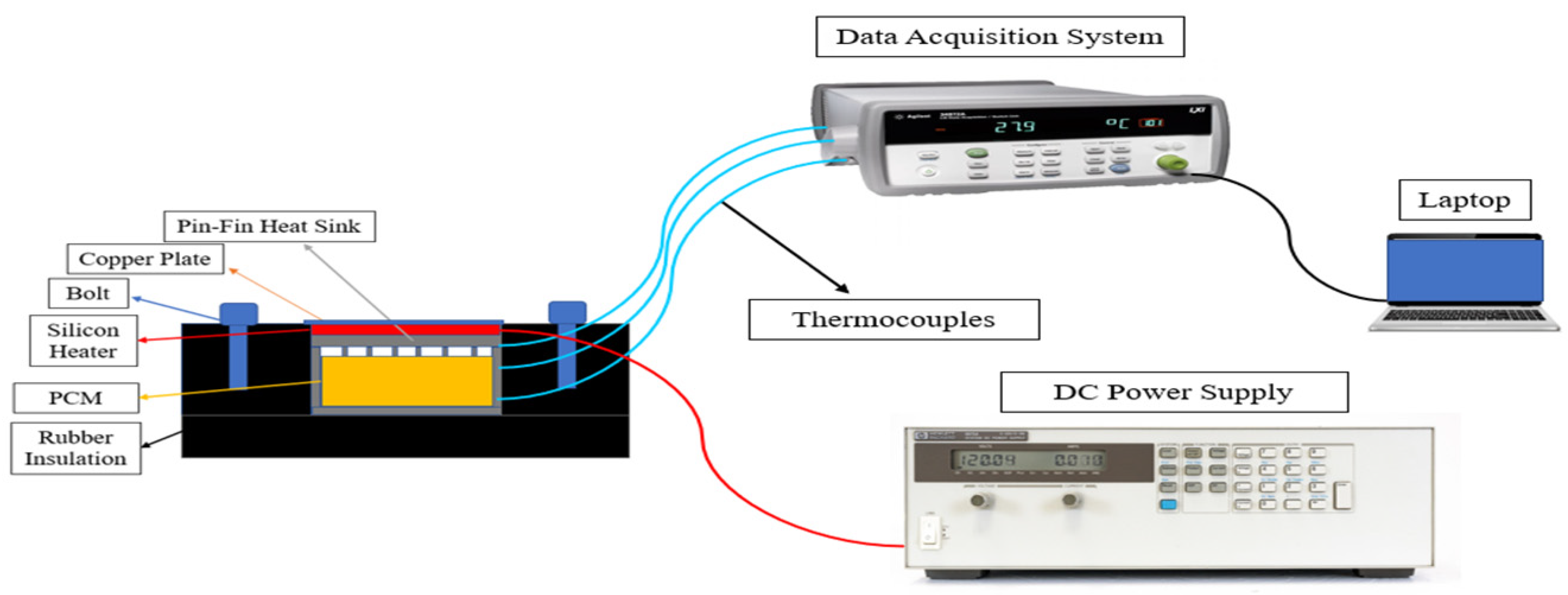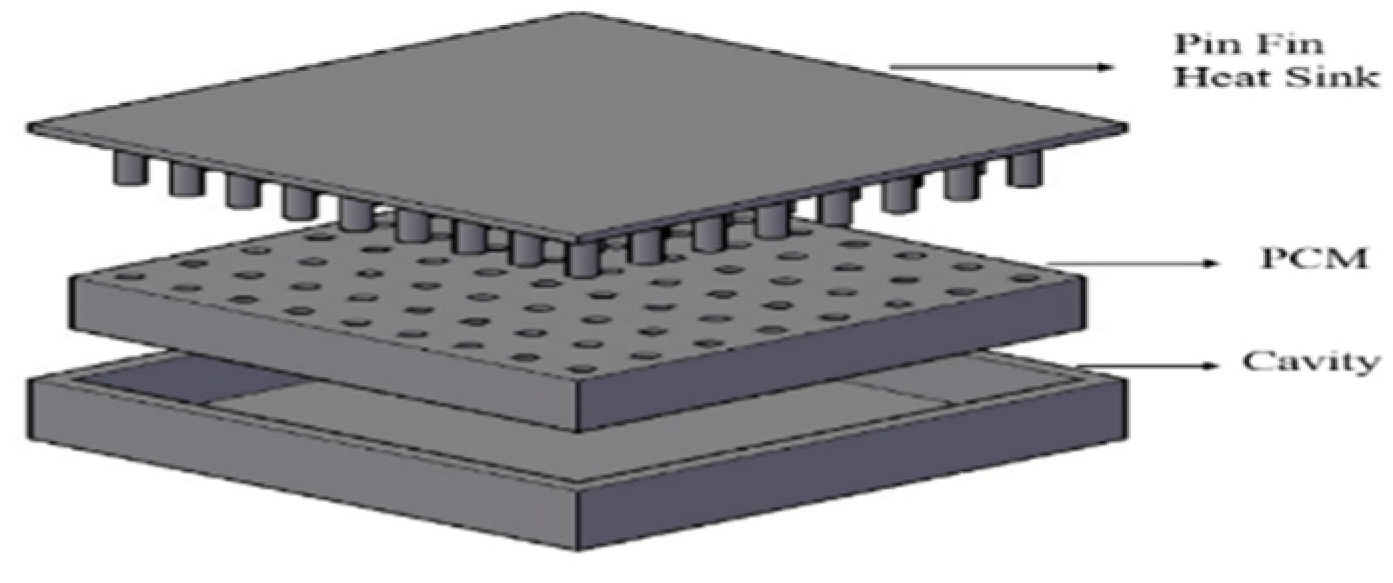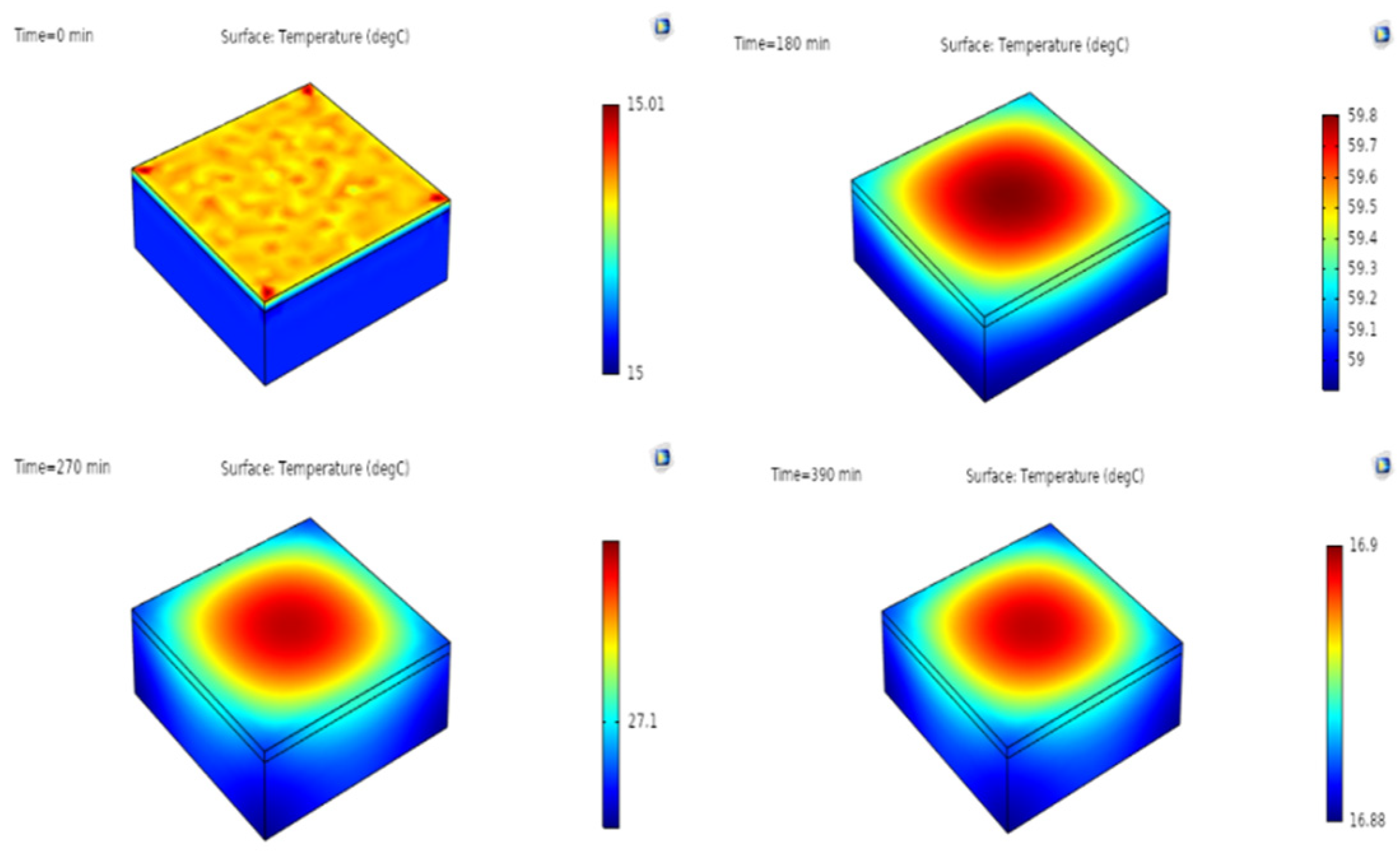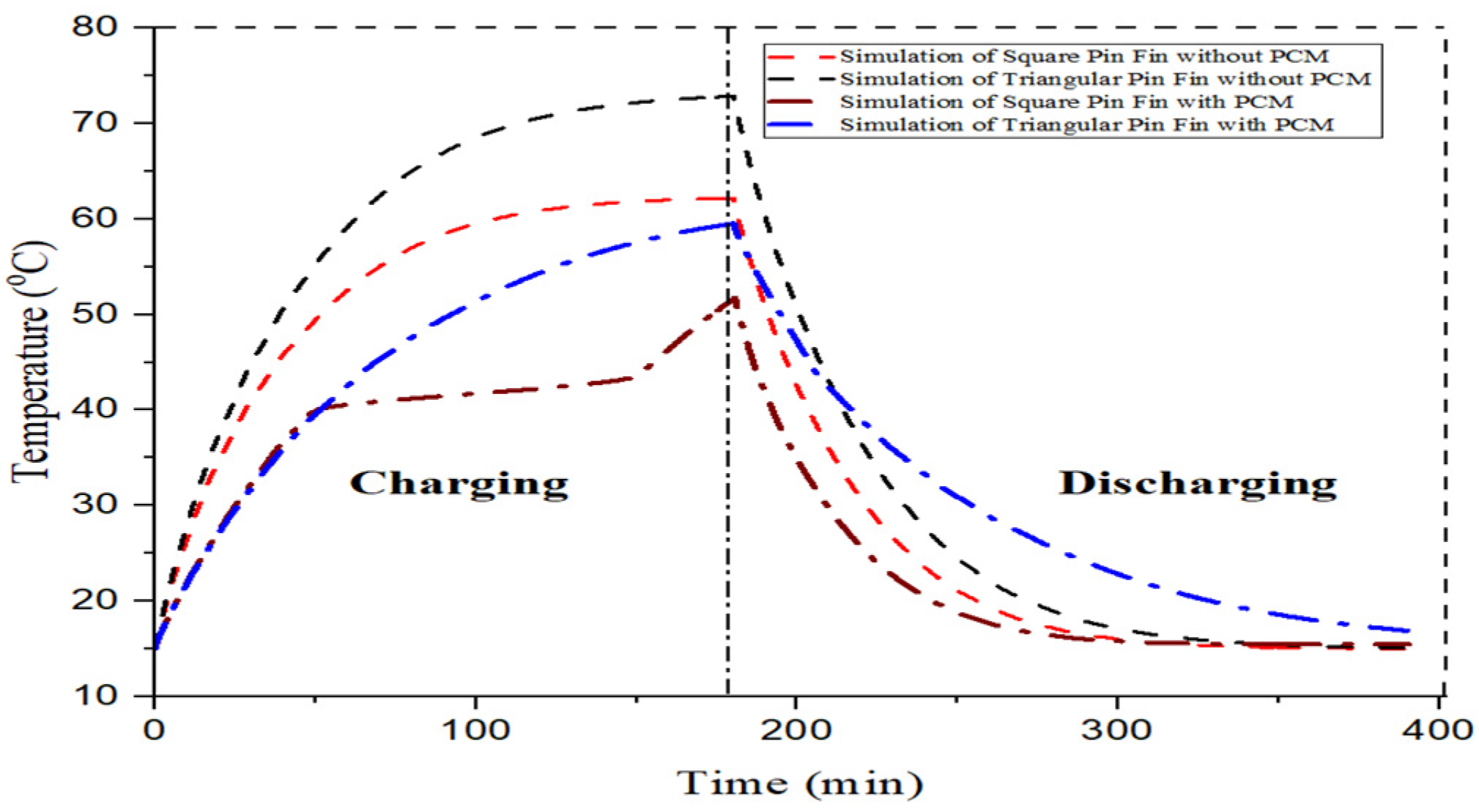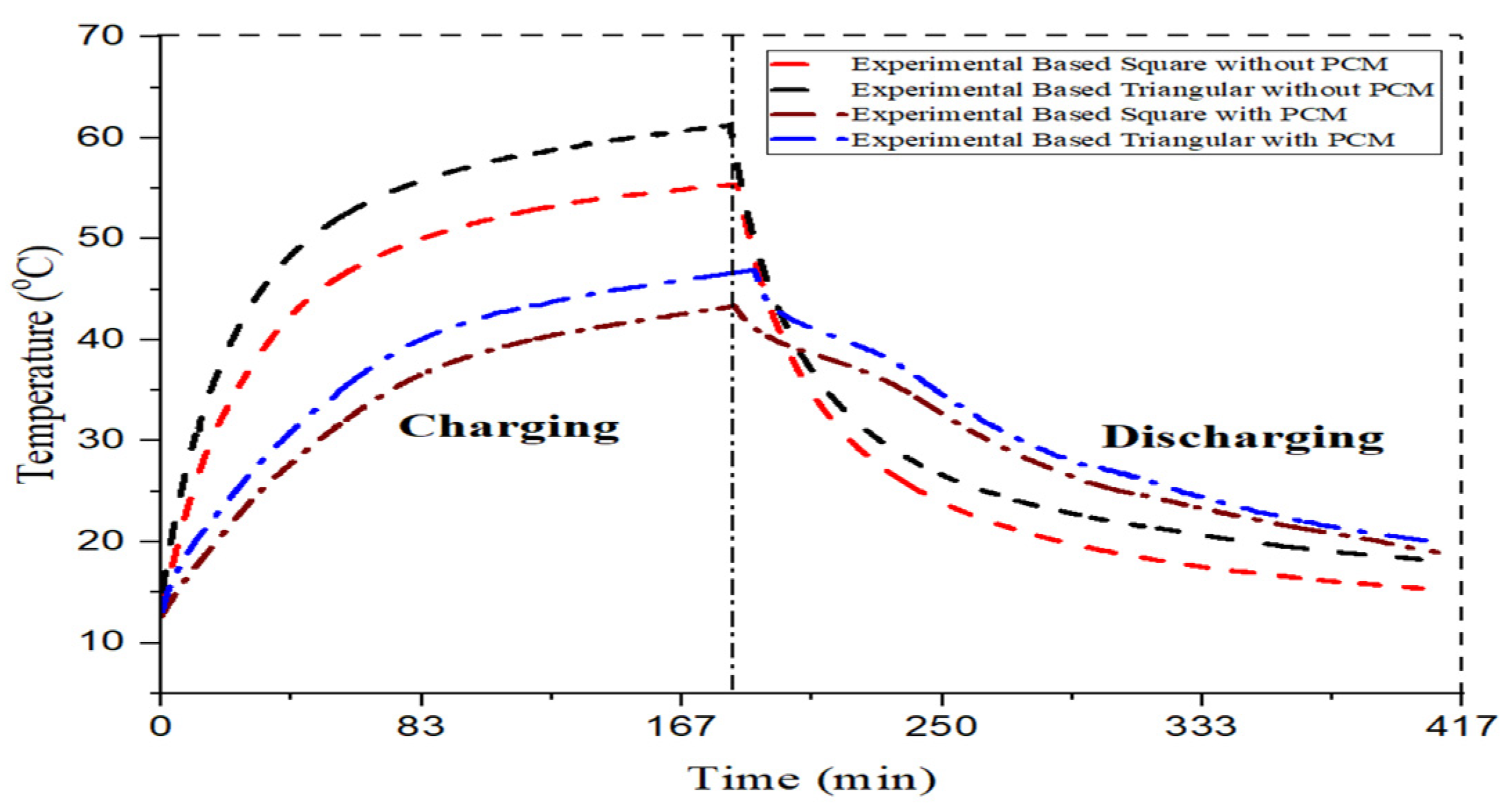1. Introduction
Recent advancements in electronics have led to an exponential rise in the temperature and heat transfer rates, which are affected due to their smaller sizes [
1]. The main purpose of heat sinks is to cool electrical equipment. Pin- and plate-finned heat sinks are the two key forms that increase thermal performance. [
2]. There are wide range of heat sink design geometries, although the most common pin fin designs are square, triangular, circular, and elliptic shapes. The performance of heat sink is significantly impacted by increasing the number and thickness of fins [
3]. Phase change materials alter their phases by absorbing a huge amount of heat during melting, and releasing it during solidification [
4]. Numerous studies have been already performed on PCM conductivity, and to overcome this problem, researchers tend to add fin geometries, composites metal, and ultrafine particles in addition to PCM [
5].
This study focuses on the numerical model investigation of various arrangements of (square and triangular) pin fin heat sinks with and without PCM. Numerical simulations using COMSOL Multiphysics 5.5 with various parameters were studied on finned heat sinks. Variables such as heat transfer rate, base temperature reduction, and the maximum temperature of all configurations were analyzed.
2. Numerical Methodology and Materials
In this study, a fin model for thermal performance characteristics is presented. The model was generated in AutoCAD software and imported into COMSOL Multiphysics 5.5. Aluminum grade 2024 was selected for both configurations. Two arrangements of pin fin configurations (square and triangular) were studied in this research (
Figure 1). The base plate of the pin fin configurations had a surface area of 114 × 114 mm
2, and the thickness of the base plate was 4 mm. There were 72 fins in total, which were extruded up to 25 mm above the base plate (
Table 1).
3. Experimental Setup
A comparison between heating and cooling of heat sink was conducted by employing different arrangements of pin fin heat sinks, i.e., square and triangular, with and without PCM. A power level of 10 W was used for this experiment and the heat sink discharged in the same way it charged, with the sidewalls and base insulated to enable heat flow in only one direction—from top to bottom—for thermal analysis. The experimental setup and exploded view of the heat sink assembly for this study are shown in
Figure 2 and
Figure 3. Subsequently, the temperature contours of heat sink at different intervals of time are presented in
Figure 4.
4. Results and Discussion
This study consisted of two phases: fins without PCM, and fins with PCM. The first set of simulations, performed for fins without PCM, and the second set of simulations, performed for fins with PCM, for both configurations, are shown in
Figure 5.
The reductions in base temperature are clearly seen by the in addition of PCM. Both configurations yielded the best results and maximum reduction in the base temperature of 17.7% with the square configuration, whereas the triangular configuration reduced the base temperature by up to 17.1%.
An experimental comparison of both configurations, with and without PCM, is shown in
Figure 6. The maximum temperature reductions by square and triangular pin fins are 19% and 16%, respectively.
Validation
Simulation results were compared with experimental data to validate the model shown in
Figure 7. The observed error range was 2% for the pin fin with PCM and 3% for the pin fin without PCM, which was calculated using the formula: [Percentage error = Numerical Value—Experimental Value/Numerical Value], which was negligible. Overall, the numerical results showed the best results with the experimental data, indicating that the model was logical.
5. Conclusions
This study focused on the reduction in base temperature in electronic applications. Numerical analyses of square and triangular pin fins provided the same results as the experimental data. The results concluded that adding PCM into the square configuration reduced the temperature by up to 17.7% as compared with a pin fin without PCM. The maximum peak temperature of the square pin fin without PCM was 62.1 °C, whereas the maximum peak temperature with PCM in the same configuration was 51.2 °C. The experimental results of the square configuration showed a maximum base temperature reduction of up to 19%. The present numerical simulation results of COMSOL Multiphysics were validated with an experimental model with the same pattern. Overall, the square configuration demonstrated better results for temperature reduction, due to the difference in surface area.
Author Contributions
H.F.: Conceptualization, methodology, validation, formal analysis, investigation, resources, data curation, writing—original draft preparation, T.B.I.: software, A.H.: writing—review and editing, supervision. All authors have read and agreed to the published version of the manuscript.
Funding
This research received no external funding.
Institutional Review Board Statement
Not applicable.
Informed Consent Statement
Not applicable.
Data Availability Statement
Not applicable.
Conflicts of Interest
The authors declare no conflict of interest.
References
- Hithaish, D.; Saravanan, V.; Umesh, C.K.; Seetharamu, K.N. Thermal Management of Electronics: Numerical Investigation of Triangular Finned Heat Sink. Therm. Sci. Eng. Prog. 2022, 30, 101246. [Google Scholar] [CrossRef]
- Jaffal, H.M.; Jebur, H.S.; Hussein, A.A. Numerical and Experimental Investigations on the Performance Characteristics for Different Shapes Pin Fin Heat Sink. IJOCAAS 2018, 4, 330–343. [Google Scholar]
- Ali, S.A.; Al-Zuhairy, R.C.; Kubba, A.I. Three-Dimensional Numerical Simulation of Heat Transfer for Different Shapes of Heat Sinks. J. Mech. Eng. Res. Dev. 2021, 44, 345–362. [Google Scholar]
- Reuben Raj, C.; Suresh, S.; Vasudevan, S.; Chandrasekar, M.; Kumar Singh, V.; Bhavsar, R.R. Thermal Performance of Nano-Enriched Form-Stable PCM Implanted in a Pin Finned Wall-Less Heat Sink for Thermal Management Application. Energy Convers. Manag. 2020, 226, 113466. [Google Scholar] [CrossRef]
- Leong, K.Y.; Chew, S.P.; Gurunathan, B.A.; Ku Ahmad, K.Z.; Ong, H.C. An Experimental Approach to Investigate Thermal Performance of Paraffin Wax and 1-Hexadecanol Based Heat Sinks for Cooling of Electronic System. Int. Commun. Heat Mass Transf. 2019, 109, 104365. [Google Scholar] [CrossRef]
| Publisher’s Note: MDPI stays neutral with regard to jurisdictional claims in published maps and institutional affiliations. |
© 2022 by the authors. Licensee MDPI, Basel, Switzerland. This article is an open access article distributed under the terms and conditions of the Creative Commons Attribution (CC BY) license (https://creativecommons.org/licenses/by/4.0/).

